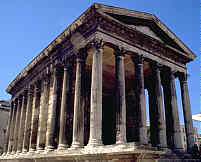
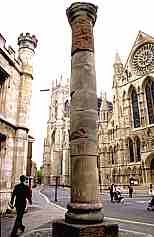
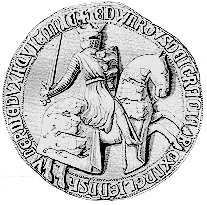
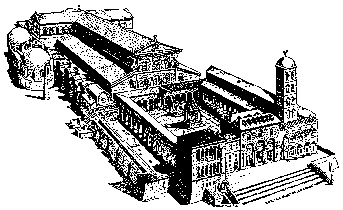

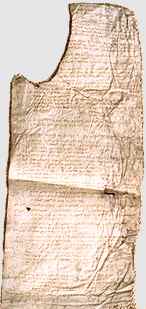

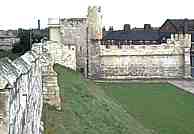

If you are looking at this page without frames, there is more information about medieval writing to be found by going to the home page (framed) or the site map (no frames).
| Types of Documents | |||
| The study of documents, by which we mean all types of legal and business records and proceedings as well as private letters, is usually undertaken by historians whose main interest is in some specialised aspect of their content. They have not been regarded as art works, nor particularly as cultural objects in their own right, although they certainly could be approached that way. Consequently processes of classification and standardisation of terminology have not been as high on the agenda as in manuscript book studies, for example. Terminology is used differently by different writers and it can become a bit confusing. We will try here to look at documents under broad functional categories and work out the terminology as we go. | |||
 |
 |
||
| Above, a Roman temple in Nimes, southern France. At right, a battered Roman column re-erected outside York Minster where it was discovered buried in the foundations. | |||
| After the fall of the Roman Empire, the use of literate process for the conduct of legal and business affairs had a divergent history. In Italy, southern France and parts of Spain, Roman law and Roman literacy continued. Notaries drafted legal documents, there were written codes of law and business people conducted their affairs in writing. In France, Germany and Britain and other countries of northern Europe, literate processes were learned again from the beginning. The range and variety of documents steadily increased during the course of the middle ages as literate process became more complicated and recordkeeping became more significant. (See Clanchy 1993 also Bagley 1972 also Elton 1969 also Bischoff 1990.) | |||
| Initially, a document was something that was handed out as a token of good faith in respect of a legal transaction. Later more assiduous attempts were made to keep records of these privileges or transactions as the written word itself became more significant than the oral testimony of witnesses. The devolution of authority from a single central agency, the king, to more local bodies caused a proliferation of written records, as did the increasing complexity of arrangements within the central agency. | |||
| The oldest documents are royal charters, diplomas or writs. These terms are not entirely synonymous, but they overlap to a degree in usage. The main point is that they all refer to an organisation of authority in which all power derives from the king. This is positively tribal in concept and derives from early medieval small scale societies in which power relations among the most significant members of society were conducted at a highly personal level. Kings and magnates traded favours, wives and daughters and competing claims to the monarchy. The legal procedure of sending out documents under the imprimatur of the king lasted into a much more complex bureaucratic age in which the king's power was devolved in various ways, but the old formula remained. |
 |
||
| The great seal of Edward I, showing the traditional representation of the king as an active leader in war. | |||
 |
Reconstruction of the ancient basilica of St Peter in Rome. | ||
| The papal bulls by which the pope asserted authority over the whole of western Christendom bear a structural relationship to the royal charters and writs, but they grew out of the literate mode of administration that had a continuing history from Classical Rome. The fact that they also have a tribal authoritative overtone may reflect the competing power relations with secular authority over the centuries and the need to mix it with these gradually civilising barbarians in terms they could understand. The medieval Catholic church was a pretty big tribe. | |||
| The array of types of documents associated with the royal chanceries became more elaborate as the process became more literate and the bureaucracy more complex. Petitions to the king were written rather than presented in person. Answers were in the form not only of charters and writs, but letters patent and letters close and were issued from various royal secretariats. Warrants were passed between the various agencies with instructions as to how to proceed. | |||
| As great numbers of these documents became scattered all over the landscape, most have become lost along with the odd socks of history. However, the process began to require some systematic process of recordkeeping in which copies of the documents were retained by the agencies which issued them, as well as by the recipients. In England, Domesday Book is an early, if over ambitious, attempt at major record keeping, but over the centuries the various royal agencies began to preserve great rolls of records of their written output. Exchequer rolls recorded the affairs of the royal treasury. | |||
| The recipients of royal favours, whether monastic houses or secular aristocracy, preserved copies of their charters in cartularies. The process of recording extended through the church and bishops kept registers with copies of their written affairs. Their inspections of the functionning of the various institutions within their dioceses produced written reports known as visitation reports which have been much used by historians to debate the moral and spiritual health of the medieval church. |
 |
||
| Tomb effigy of a bishop in Winchester Cathedral; spiritual leader as well as administrator and bureaucrat. | |||
| The charter format gradually spread down the social scale from the monarch to the senior aristocracy, the gentry and to ordinary citizens. Among these private charters it seems that the form is sometimes used to testify to the existence of a transaction between individuals of equal status rather than implying, as in a royal charter, that one party has the power and authority to grant privilege to a lesser party. At this level the term is interpreted somewhat loosely and some writers use it to refer to all kinds of written transactions between individuals, including various kinds of business agreements and formal letters. The notarial document eventually re-emerged in northern Europe as a means of creating a legal agreement, having had a continuous existence since the days of Classical Rome in Italy and the south. Another form of written agreement between two parties was the indenture or chirograph, in which the agreement was written out in duplicate and the two halves separated with a zigzag cut. | |||
| Part of the devolution of royal authority involved an increasing complexity of the justice system. The recording of cases on plea rolls and in concise form in year books allowed the development of case law based on precedent. |  |
||
 |
|||
| Above, and early 15th century effigy of Judge William Gascoigne in his legal robes in Harewood parish church, Yorkshire. At right, a fragment of a court roll from Barnsley, Yorkshire, in a private collection. | |||
| The laws themselves were preserved in elegant volumes. Their prestige was often indicated and enhanced by elaborate decoration. | |||
| The granting of borough charters to towns by royal authority or through other lordship over the town generated another level of recordkeeping and proliferation of documents. The records of various town officials from the later middle ages are preserved in many local archives and record offices. By-laws and licences and certificates of good conduct and all the other things we are so used to today became part of town life. The records of guilds also provide insight into aspects of medieval urban living. |
 |
||
| The gate known as Walmgate Bar in York preserves its barbican, symbolising the control held by town corporations over entry and egress to the city. | |||
| Financial records of various types have also been preserved, although often scattered around various archives. Merchants and business men kept records, but the running of a manor or of a monastery also represented significant financial enterprises and their records can provide important insights into many aspects of rural life. Medieval systems of accounting have their peculiarities which need to be understood to make proper sense of these documents. (See Tillotson 1988) | |||
| We get to a more personal and individual involvement in the later medieval period with the survival of numbers of wills and associated inventories of personal possessions. Here we have an insight into the material culture of the era and the attitude to and valuation of it. Clothes, household goods and precious possessions are all evaluated and apportioned. The nature of relationships among family members can be explored. Attitudes to personal commemoration after death may be revealed from instructions in wills. |  |
||
| A lavish 15th century tomb serves to enhance family pride in the small parish church of Burton Agnes in Yorkshire. | |||
| There are few truly personal letters surving from before the 12th century. However an increasing number from later in the middle ages gives a perspective that is genuinely individual. The most famous major collection, that of the Paston family in England, gives an intriguing view of both family and neighbourhood relationships that could be tempestuous, even violent. However, unlike the formal documents of government and religious institutions, there is no strict structure to guide enquiry. We all like to poke our noses into other people's private affairs, even if they have been dead for 500 years, but utilising this free ranging body of evidence to address historical questions can be a tricky exercise of interpretation. | |||
|
|
|||
|
If you are looking at this page without frames, there is more information about medieval writing to be found by going to the home page (framed) or the site map (no frames). |
|||